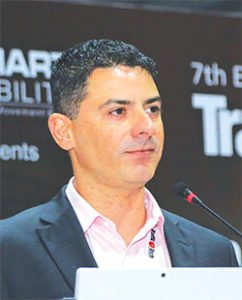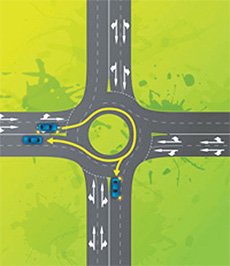
“It has always been about keeping people safe and getting people home alive”, stated Ravin Mirchandani, Chairman, Ador Powertron who was part of the opening session on Highways at the Driving Smart Mobility 2018 Conference
The situations we have in our country demand resilient and robust road safety products and solutions. We have a unique set of challenges on Indian roads that are vastly different from road circumstances globally. Safety on our roads today is impacted by speeding, driving under the influence of alcohol and drugs, traffic management systems that are not geared for Indian conditions, lack of training on driver behaviour and also poor infrastructure. Safety is also impacted by regulations that are not clearly defined, training, road specifications and finally the intent of such regulations. The intent always needs to be about changing driver behaviour so as to ameliorate safety on our roads and get people home alive.
Our challenges are unique; flooding, traffic jams, using roads weddings & as markets and a lack of proper communication to commuters on hazzards. It is interesting to see that 90% fatalities occur in low- and middle-income countries, even though less than 50% vehicles operate in these economies, Traffic accidents will kill approximately two million people every year by 2020. In order to address this, we can not simply copy paste a global enforcement solution and expect it to work.
If we look at the share of accidents on the roads in India, a third is on national highways, a third on state highways and a third on city roads. This indicates that our problems are complex.
 If we further analyse fatality data generated by the various states, it becomes evident that states with better infrastructure tend to have a higher rate of accidents. Tamil Nadu which has excellent road infrastructure also has the highest road toll in the country, contributing to14.9% of the accidents in India. Just five states contribute over 50% of road fatalities in India – Tamil Nadu, Madhya Pradesh, Karnataka, Maharashtra and Kerala. Each of these has unique driver behaviours and road safety challenges and one common solution will not be able to result in any reduction in the death toll.
If we further analyse fatality data generated by the various states, it becomes evident that states with better infrastructure tend to have a higher rate of accidents. Tamil Nadu which has excellent road infrastructure also has the highest road toll in the country, contributing to14.9% of the accidents in India. Just five states contribute over 50% of road fatalities in India – Tamil Nadu, Madhya Pradesh, Karnataka, Maharashtra and Kerala. Each of these has unique driver behaviours and road safety challenges and one common solution will not be able to result in any reduction in the death toll.
In the mid 1970s, to reduce road fatalities, Australia focussed on two things, Alcohol and Speed. The moment alcohol breathalysers were introduced, road fatalities started dropping exponentially. In India too, our enforcement authorities have introduced breathalysers; however, the specifications we have adopted require breathalysers to have significant electronics including inbuilt cameras and printers. These also need to be calibrated regularly which requires lab skills typically not available to a remote highway police team.
Ador offers Alcoliser breathalysers which aim to address this unique Indian challenge. They don’t need to be calibrated by police, and are robust and resilient – capable of being dropped on a concrete road from a height of two meters. Further, they don’t need a consumable to be used with every breath test; it is needed only when alcohol is detected, greatly reducing the cost of consumables to police forces.
The second challenge that Australia focused on was speed enforcement. From 1985 to 1993 significant infrastructure expansion took place, driving speeds went up and with that the fatalities increased exponentially. During the late 1980s, Australia introduced laser guns, radar guns and finally speed enforcement cameras resulting in a continuous drop in fatalities on roads nationwide since 1990 to 2017.
 Speeding is a major source of fatalities across the globe in developing countries because the infrastructure for enforcement is poor. Replication of solutions from Dubai or Singapore such as Point to Point Average Speed ANPR will not address speeding on straight stretches, narrow bends, poor number plate compliance etc.The challenge is that we do not have standardised number plates. ANPR solutions typically commence with an enforcement rate of approximately 60% at each location. When Point-To-Point average speed is incorporated, that means 60% over two locations, enforcement rates can drop as low as 30%. This will not result in driver behaviour change or facilitate safer roads.
Speeding is a major source of fatalities across the globe in developing countries because the infrastructure for enforcement is poor. Replication of solutions from Dubai or Singapore such as Point to Point Average Speed ANPR will not address speeding on straight stretches, narrow bends, poor number plate compliance etc.The challenge is that we do not have standardised number plates. ANPR solutions typically commence with an enforcement rate of approximately 60% at each location. When Point-To-Point average speed is incorporated, that means 60% over two locations, enforcement rates can drop as low as 30%. This will not result in driver behaviour change or facilitate safer roads.
VMS should add value to a journey by helping the commuter make decisions on travel time, safety and on congestion. Ador decided to focus on these unique problems. We looked at changing driver behaviour on roads from an Indian perspective of being resilient, capable of high levels of enforcement (99%+) and from a perspective of local communication challenges.
Ador has invested in an Australian company which specialised on driver behaviour change solutions using radars and cameras. Together, both companies designed a radar & camera based speed enforcement solution that requires very little power and very low data bandwidth to operate (no electricity or firbe cables required – only solar power and 2G GSM). This India specific resilient solution uses a 9-megapixel camera, triggered by a radar that can cover six to eight lanes of reciprocal traffic directions and identify vehicles that are speeding. It uses a GSM modem on 2G, to email or to a call centre control room the number plate is read, and e-challan is created. The system can be set up in less than half a day and has demonstrated already a 99% enforcement result in live Indian conditions as every number plate in every language is capable of being read. The system does not rely on any ANPR software. It is also available to be installed on mobile vehicle platforms in a plug and play set up condition.
The other challenge we have on Indian roads is that our Variable Messagwe Sign (VMS) specifications allow for cheap imported LED commercial walls to be used on highways. These are also used by local authorities for advertising revenue, which can be quite dangerous and distracting when located on an overhead gantry. A MS should communicate the travel conditions, information about accidents, flooding, lane closure, road works, congestion, etc to commuters. This will help avoid further accidents when road conditions are changed and also help alter driver behaviour to suit altered road conditions. There is a regulation that says VMS should not be used for adverts or for videos but 90% of use is just that.
Also a VMS is not just a sign; it is an electronic board that requires constant servicing. So access to the VMS without blocking traffic, the ability to service the unit safely from the rear without endangering the lives of motorists below from tools or parts falling on their windscreen etc becomes very important. So, as no exiting safe designs were available in the country, Ador also designed a VMS pole that is Australianapproved VMS pole which is safe for both technicians and road users, does not require traffic stoppage to access the VMS and most importantly is vandal-proof with restricted access as well. The foundations are also carefully designed to be above the flood water line as each VMS also has a junction box with UPS, batteries, converters and can work on solar or it can work on electricity.
Ador had also introduced the first road safety roller barriers in India. It is a unique MASH 4 certified innovation to address highway blackspots in India. The first project is done on the east coast road in Tamil Nadu. This is a product that allows the kinetic energy of a vehicle that is breaching the road to be used so as to move the vehicle along the barrier and keep it on the road rather than have the vehicle crash through the barrier. The other benefit is that the barriers need not be replaced every time there is an accident because it flexes and comes back to its zero position.
Ador’s focus has been safe roads through smarter solutions to help bring people home safe every day. The solutions are designed for India and made in India, which means they are robust, easy to operate and frugal.
 TrafficInfraTech Magazine Linking People Places & Progress
TrafficInfraTech Magazine Linking People Places & Progress